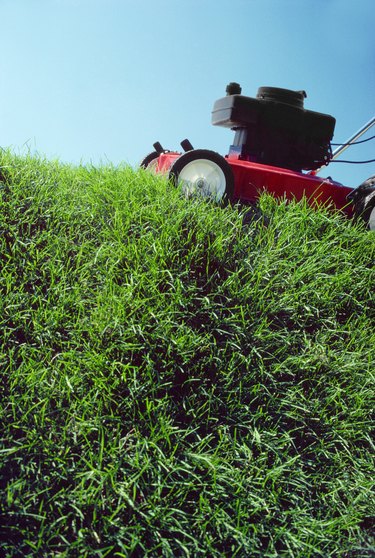 Proper blade installation is essential for mowing. Image Credit: Jupiterimages/liquidlibrary/Getty Images
Proper blade installation is essential for mowing. Image Credit: Jupiterimages/liquidlibrary/Getty Images
Whether you are sharpening an existing blade or installing new blades, proper blade orientation is very important. If you install a blade incorrectly, your mower may not cut properly. In some cases, improper blade installation can even cause the blade to work loose from its mounting; if this occurs, damage to the mower or even potentially serious injuries can result.
Video of the Day
Removing Old Blades
One of the best ways to determine the proper orientation of a mower blade is to pay attention to how the old blade was mounted. Make sure that the mower's spark plug is disconnected and tilt the mower so that you can access the blade. Hold the blade with a leather glove, then remove the bolt or bolts holding it to the mounting plate. Take note of how the blade is positioned and how it connects to the mounting plate, then remove it.
Installing New Blades
Some blades have markings indicating which side should face up, making it easy to tell how the blade goes on the mower. If your blade doesn't and you weren't able to reference it to the old blade, look at the cutting edge of the blade. Most lawn mower blades rotate in a clockwise direction (counter-clockwise when viewed from below), and as such have the cutting edge on the right side. If you are unsure of how your mower rotates, check the position of the discharge chute; if it is on the right side angled back, the blade turns clockwise. Once the blade is properly oriented, place it onto the mounting plate and mount it using the retaining hardware.
Using the Right Blade
Different mowers sometimes use different blade designs, and using the wrong blade type sometimes results in installation problems even if the blade is oriented correctly. This shouldn't be a problem if you are sharpening an existing blade, but if you're buying a new one then it's important to choose a blade that's compatible with your mower. Check the blade's packaging to see if it is compatible with your specific mower. If you aren't able to determine that from the packaging, consult the owner's manual for your mower or physically check the design of the mounting hardware to ensure that you select a blade that has the proper mounting holes to fit your mower.
Specialty Blades
If you are installing a specialty blade such as a mulching blade, it may not immediately be clear which way you should mount it. These blades often have a smaller cutting edge to accommodate ridges or bends in the blade's design. Locate this cutting edge and base your orientation on that. Special blade features such as "teeth" should rise up from the back of the blade once installed; these features are typically designed to control airflow within the mower deck, and therefore won't come in contact with uncut grass at all.



























